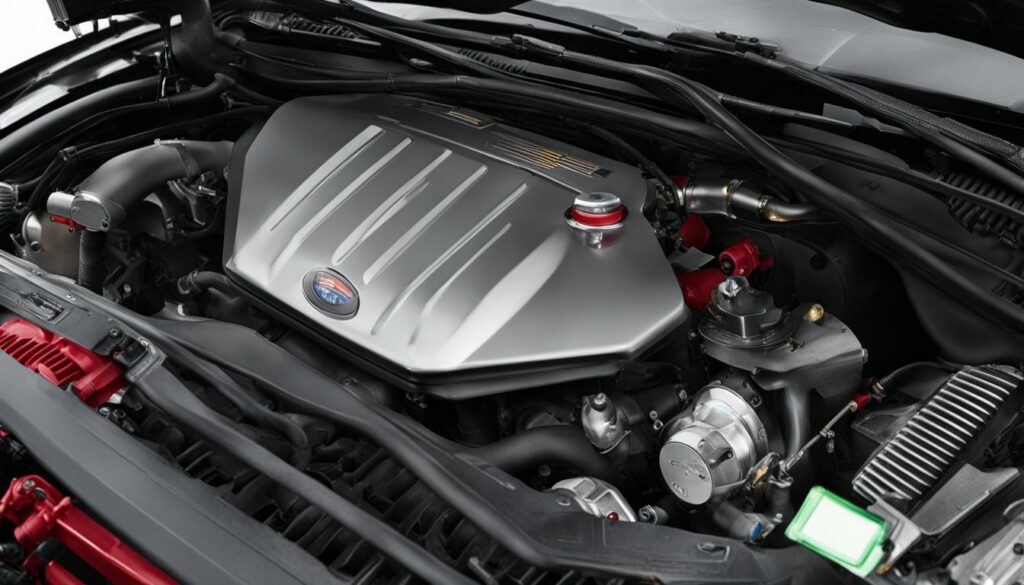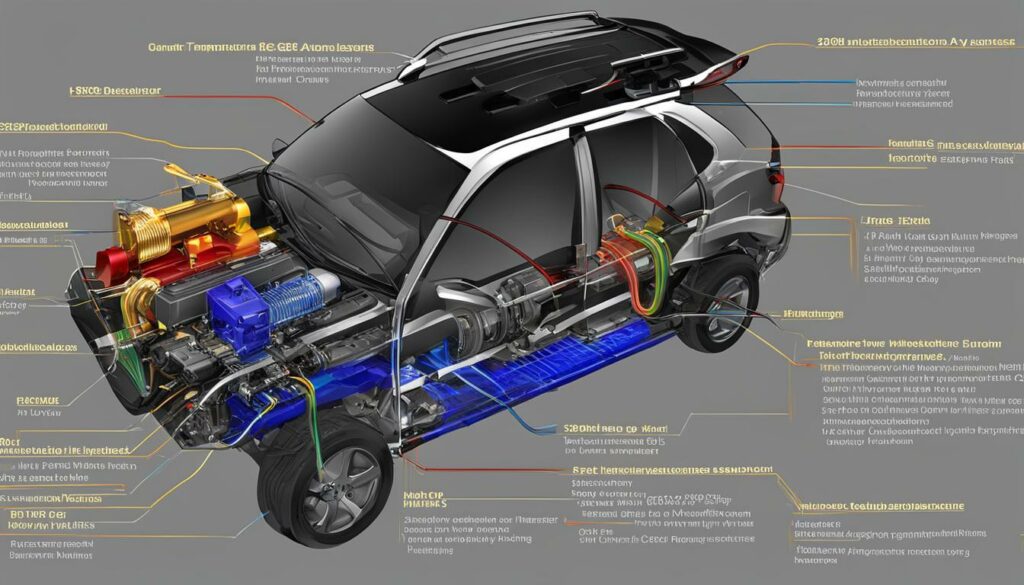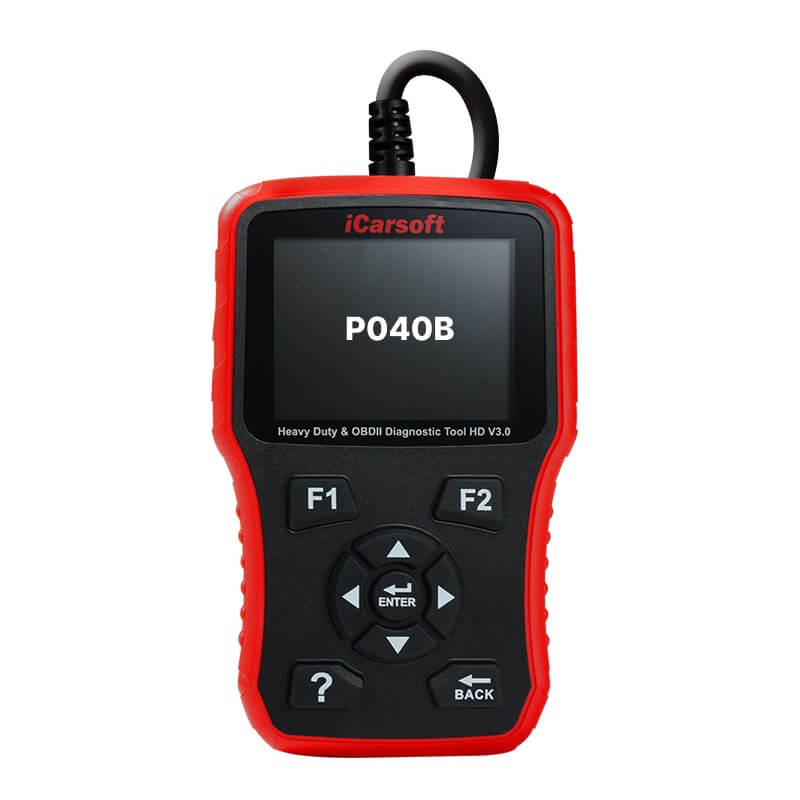P040B – Exhaust Gas Recirculation Temperature Sensor “B” Circuit
POSTED IN pcodes
Welcome to our article on the P040B code, which refers to the Exhaust Gas Recirculation (EGR) Temperature Sensor “B” Circuit. If you’re experiencing issues with your vehicle’s EGR temperature sensor, this guide will provide you with valuable information on diagnosis and repair. Whether you’re a DIY enthusiast or a professional mechanic, understanding the P040B code and its causes is crucial in ensuring the proper functioning of your vehicle’s exhaust gas recirculation system.
Key Takeaways:
- The P040B code is a generic powertrain code that applies to OBD-II equipped vehicles.
- The EGR temperature sensor measures the temperature of the exhaust gas and can trigger the P040B code if it doesn’t meet factory specifications.
- Common causes of the P040B code include issues with the EGR temperature sensor, wiring, connectors, engine control module, or exhaust gas recirculation system.
- Diagnosing the P040B code involves visual inspection, retrieving stored codes, and analyzing scanner data.
- To repair the P040B code, it is recommended to replace or repair faulty parts, such as the EGR temperature sensor, engine control module, or related wiring.
Symptoms of P040B Code
The P040B code can cause a variety of noticeable symptoms in your vehicle. If you experience any of the following issues, it is crucial to address them promptly, as they could indicate problems with the exhaust gas recirculation system and the EGR temperature sensor.
Louder Exhaust Noise
One symptom of the P040B code is a louder exhaust noise. You may notice an increase in engine noise or a distinct exhaust sound coming from your vehicle. This can be a result of improper functioning of the exhaust gas recirculation system and may require attention to prevent further damage.
Failing Emissions Tests
In some cases, a failing emissions test can be a sign of the P040B code. If your vehicle fails an emissions test, it means that there is a malfunction in the exhaust gas recirculation system, which can lead to increased pollutants being emitted from the vehicle.
Strong Exhaust Smells
If you notice a strong odor coming from your vehicle’s exhaust, it could be a symptom of the P040B code. The malfunctioning exhaust gas recirculation system can lead to a mixture of exhaust gases that produce a distinct and unpleasant smell.
Buy tested tuning file for Adblue / EGR / DPF / Adblue off now!
Engine Noises
Another symptom of the P040B code is engine noises such as knocking or rattling. This can be caused by improper combustion due to issues with the exhaust gas recirculation system and the EGR temperature sensor. Ignoring these noises can result in further damage to the engine.
Service Engine Soon Warning Light
The illumination of the service engine soon warning light on your dashboard is a common indicator of the P040B code. This warning light signifies a problem with the vehicle’s emissions system, including the exhaust gas recirculation system and the EGR temperature sensor.
Addressing these symptoms promptly and seeking professional assistance is crucial to prevent further damage to your vehicle’s exhaust gas recirculation system and ensure optimal performance.

Summary of P040B Code Symptoms
| Common Symptoms of P040B Code |
|---|
| Louder exhaust noise |
| Failing emissions tests |
| Strong exhaust smells |
| Engine noises (knocking or rattling) |
| Service Engine Soon warning light |
Causes of P040B Code
The P040B code can be triggered by various factors that disrupt the proper functioning of the Exhaust Gas Recirculation (EGR) system and the EGR Temperature Sensor. These causes include:
- Quirks in the connector
- Malfunctioning engine control module
- Defaults in the EGR temperature sensor or its wiring
- Leaking EGR temperature sensor gasket
- Cracked or leaking exhaust pipe
- Poor connections
- Defects in the EGR temperature sensor or its harness
- Low engine coolant
- Faulty exhaust temperature sensor
“These issues can disrupt the proper functioning of the exhaust gas recirculation system and lead to the triggering of the P040B code.”
To accurately diagnose and resolve the P040B code, it is essential to address these underlying causes through proper inspection, testing, and repair or replacement of the affected components.

EGR Temperature Sensor Comparison Table
| EGR Temperature Sensors | Resistance (Ohms) | Temperature Range (°C) |
|---|---|---|
| EGR Temperature Sensor “A” | 0-1800 | -40 to 260 |
| EGR Temperature Sensor “B” | 0-1800 | -40 to 260 |
| EGR Temperature Sensor “C” | 0-1800 | -40 to 260 |
Diagnosis of P040B Code
To properly diagnose the P040B code, you or your mechanic will need to perform a series of inspections and tests. These steps will help identify the underlying issues with the Exhaust Gas Recirculation (EGR) Temperature Sensor and the Exhaust Gas Recirculation (EGR) System.
Visual Inspection
Start by visually inspecting the EGR temperature sensor, its wiring harness, and the entire EGR system. Look for any signs of damage, loose connections, or leaks. Make sure all components are securely fastened and in good condition.
Diagnostic Scanner
Next, use a diagnostic scanner to retrieve the stored codes and freeze frame data related to the P040B code. This data will provide valuable insight into the conditions under which the code was triggered. Additionally, you can test drive the vehicle to see if the code is reset during normal driving conditions.
Data Analysis
Analyze the scanner data stream to identify any correlation problems between the two EGR temperature sensors. These sensors should provide similar readings under normal operating conditions. If there is a significant discrepancy, it may indicate a faulty sensor or a programming error in the Powertrain Control Module (PCM).
Temperature Testing
If necessary, your mechanic can test the EGR temperature sensors using specialized tools. They can simulate different temperature conditions and compare the sensor readings to ensure their accuracy. Additionally, they can use an infrared thermometer to check the exhaust gas temperature at the EGR cooler inlet and outlet, validating the proper functioning of the system.
By following these diagnostic procedures, you or your mechanic can pinpoint the specific issues causing the P040B code. This information will guide the repair process and help restore the proper functioning of the EGR temperature sensor and the entire EGR system.
| Diagnostic Steps for P040B Code |
|---|
| 1. Visual inspection of the EGR temperature sensor, wiring harness, and EGR system |
| 2. Retrieve stored codes and freeze frame data using a diagnostic scanner |
| 3. Test drive the vehicle to observe code reset behavior |
| 4. Analyze scanner data stream for correlation problems between EGR temperature sensors |
| 5. Test EGR temperature sensors and compare readings under different temperature conditions |
| 6. Use an infrared thermometer to measure exhaust gas temperature at EGR cooler inlet and outlet |
Repair of P040B Code
To address the P040B code, it is crucial to undertake the necessary repairs and replacements. Here are the recommended steps:
- Carefully repair the defective connector: Inspect the connector for any signs of damage or corrosion. If any issues are detected, repair or replace the connector to ensure a secure connection.
- Replace or repair the faulty engine control module (ECM): If the ECM is malfunctioning, it can contribute to the triggering of the P040B code. Consider replacing or repairing the ECM to restore its proper functionality.
- Repair any flawed wires: Examine the wiring connected to the EGR temperature sensor and the exhaust gas recirculation system. If there are any damaged or faulty wires, repair or replace them as necessary.
- Ensure proper connections: Check all connections related to the EGR system and the EGR temperature sensor. Make sure the connections are secured tightly and free from any dirt or debris. Clean or replace connectors if needed.
- Replace or repair the exhaust gas recirculation temperature sensor: If the EGR temperature sensor is causing the P040B code, consider replacing it with a new one. Ensure that the replacement sensor meets the required specifications. Alternatively, repair the sensor if possible.
- Correct any leakage in the EGR temperature sensor gasket: Inspect the gasket between the EGR temperature sensor and its housing for any leaks. Replace the gasket if necessary to prevent any exhaust gas leakage.
- Address other potential causes: It’s important to investigate and resolve any additional issues that may be contributing to the P040B code. Check for faults in other components, such as the throttle position sensor, fuel temperature sensor, coolant temperature sensor, ambient air temperature sensor, and engine control module. If any faults are found, repair or replace the faulty components.
Infrared Thermometer Test
If needed, a mechanic can use an infrared thermometer to measure the exhaust gas temperature at the EGR cooler inlet and outlet. This test can provide valuable data to diagnose any temperature discrepancies that may be causing the P040B code.
By following these repair steps and addressing any underlying issues, you can effectively resolve the P040B code. Restoring the proper functioning of the exhaust gas recirculation system, as well as the EGR temperature sensor, is essential for optimal vehicle performance and emission control.
Conclusion
The P040B code is a diagnostic trouble code that indicates an issue with the Exhaust Gas Recirculation (EGR) Temperature Sensor Circuit. This code can be triggered by various factors, including faults in the EGR temperature sensor, wiring, or connectors, a malfunctioning engine control module, or issues with the exhaust gas recirculation system.
To diagnose and repair the P040B code, it is important to inspect the EGR temperature sensor and system, retrieve and analyze stored codes, and perform necessary repairs or replacements. By addressing these issues, the P040B code can be fixed, ensuring the proper functioning of the EGR temperature sensor and the exhaust gas recirculation system.
If you encounter the P040B code, it is recommended to consult a professional mechanic or automotive technician who has experience in diagnosing and repairing EGR temperature sensor circuit issues. They will have the expertise and specialized tools to properly diagnose the problem and provide the necessary repairs to resolve the P040B code.
FAQ
What does the P040B code mean?
The P040B code refers to the Exhaust Gas Recirculation (EGR) Temperature Sensor “B” Circuit. It is a generic powertrain code that applies to OBD-II equipped vehicles.
What is the function of the EGR temperature sensor?
The EGR temperature sensor is responsible for measuring the temperature of the exhaust gas and increasing resistance with increasing temperature.
What are the symptoms of the P040B code?
The symptoms of the P040B code can include louder exhaust noise, failing emissions tests, strong exhaust smells, engine noises like knocking or rattling, and the illumination of the service engine soon warning light.
What are the common causes of the P040B code?
The common causes of the P040B code include issues with the EGR temperature sensor or its wiring, a malfunctioning engine control module, a leaking EGR temperature sensor gasket, a cracked or leaking exhaust pipe, poor connections, or defects in the EGR temperature sensor or its harness.
How is the P040B code diagnosed?
To diagnose the P040B code, a mechanic can visually inspect the EGR temperature sensor, its wiring harness, and the surrounding EGR system for any signs of damage or leaks. They can also use a diagnostic scanner to retrieve the stored codes and freeze frame data, test drive the vehicle to see if the code is reset, and analyze the scanner data stream to determine if there is a correlation problem between the two EGR temperature sensors or if there is a PCM or programming error.
How is the P040B code repaired?
To repair the P040B code, it is recommended to carefully repair the defective connectors, replace or repair the faulty engine control module, repair any flawed wires, ensure proper connections, replace or repair the exhaust gas recirculation temperature sensor, and correct any leakage in the EGR temperature sensor gasket.


